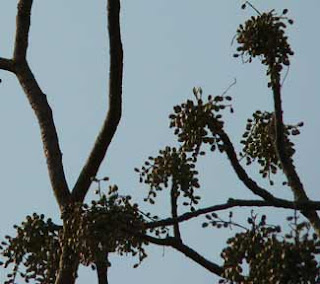Star Apple tree, commonly known as 'Chrysophyllum cainito' is a very beautiful, evergreen and medium size tree. Though it is not native to India, it has been naturalized in India. The tree is also known as Cainito, Caimito, Golden leaf tree, Milk fruit and Estrella. In Fort area of Mumbai, many beautiful specimens existed at one time; but due to road widening some have disappeared and some are trimmed badly.
The tree grows to about 15 meters high with very dense foliage. Slightly leathery leaves are dark green and glossy with the underside having brownish-golden colour. The trunk is rough. It is comparatively slow growing tree. This tree bears flowers and fruit between January to April. Flowers are mildly scented. The ripe fruit is edible and supposed to be very tasty. The rind is tough and is not edible. The rind has also milky sap which should not be ingested. The fruit when cut shows star-like formation, hence it is called as Star apple. The fruit and some parts of the tree are supposed to have medicinal properties.
This tree belongs to Sapotaceae family, to which Chiku or Sapota also belongs.
 |
| Sapling in a park |
 |
| Golden underside of leaves |
 |
| Cainito tree in Fort area of Mumbai |
 |
| Trunk of the tree |
 |
| Flowers |
 |
| Fruit |


























